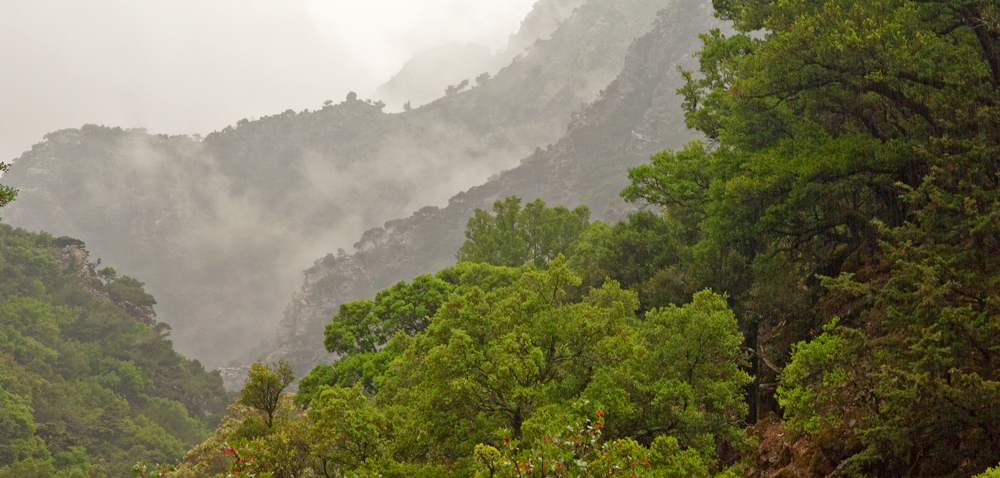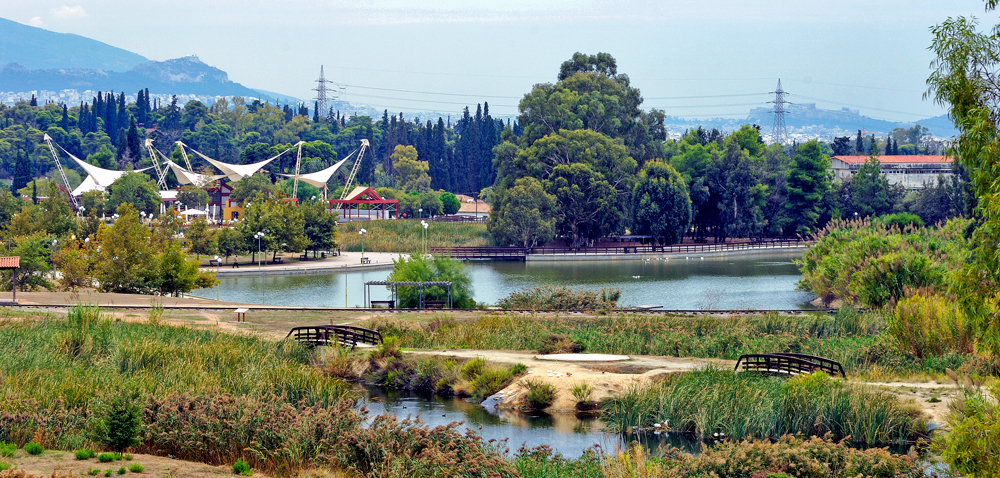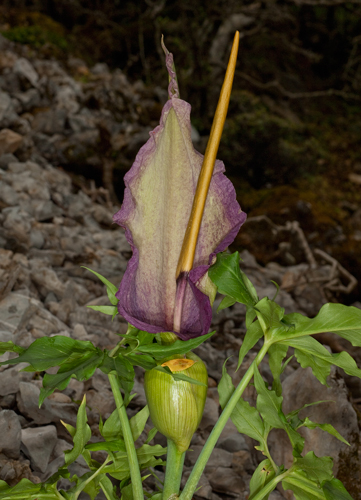Aesthetic Forests
Rouvas Forest

A dense forest in the centre of Crete distinguished for its rare type of vegetation and for the many endemic species of cretan flora and fauna present here. Rouvas forest is one of the most important kermes oak forests of Greece, as it is the only large and healthy forests of Crete, which still retains the physiognomy that characterised the mainland of the island since ancient times. It is located in the southeastern part of Psiloritis mountain in one of the most inaccessible areas of Crete. It lies in a rocky basin that creates a small valley with intense terrain, at an average altitude of 500 meters, crowned by many peaks of eastern Psiloritis. Most important of these are Halasokefala (1,917 m), Koudouni (1,857 m), Skinakas (1,750 m), Piperos (1,714 m), Ambelakia (1,441 m), Samari (1,413 m) and Kefala (1,310 m). The size of the forest reaches 6,500 acres. To the south lies the gorge of Agios Nikolaos, or Gafari gorge, which enters the valley vertically separating the mountains Ambelakia and Samari at a distance of 4 km. The stream passing through the gorge enriches the waters of the small lake of Votomos, or lake Zaros, and the large artificial lake of Faneromeni located a few kilometers south. In the north of the valley begins the Psakofarango gorge which through the famous Ammoudara gap is connected to the big plateau of Nida in the west. On the southern slopes of the forest lies the cave called Kalogeros Tripa (transl. Monks hole). From the entrance of the gorge of Agios Nikolaos, next to the homonym monastery starts a marked trail that reaches the area of Agios Ioannis of Rouvas located in the centre of the valley. The forest of Rouvas has been for centuries and during the various occupations of the island an important refuge and base of Cretans rebels. Today the ecological and aesthetic value of the area attracts hundreds of researchers and nature enthusiasts.
The predominant tree of the forest is the kermes oak (Quercus coccifera). The kermes oak forest of Rouvas is one of the largest in Europe, with impressive, centuries-old trees that have escaped the typical bushy form of the species. Along with kermes oak grow other, typical of the Cretan flora, trees such as the endemic cretan zelkova (Zelkova abelicea), evergreen oaks, pubescent oaks, mediterranean cypresses, prickly junipers, turkish pines, cretan maples, wild olive trees, mock privets, hawthorns, turpentine trees and almond-leaved pears. In the streams grow big oriental plane trees. The forest and the slopes are full of rare plants. Of these stand out many narrow endemics of Crete, such as Lomelosia sphaciotica subsp. decalvans, Ebenus cretica, Origanum dictamnus, Tulipa cretica, orchids Cephalanthera cucullata and Epipactis cretica, Asperula pubescens, Asperula rigida, Viola alba subsp. cretica, Staehelina petiolata, Allium callimischon subsp. haemostictum, Allium tardans, Eryngium ternatum, Ferulago thyrsiflora, Biarum tenuifolium subsp. idomenaeum, Centaurea idaea, Scorzonera mollis subsp. idaea, Ricotia cretica, Campanula tubulosa, Cerastium deschatresii, Dianthus juniperinus, Silene pinetorum subsp. sphaciotica, Silene sieberi, Trifolium phitosianum, Muscari spreitzenhoferi, Hypericum jovis, Prunella cretensis, Scutellaria sieberi, Teucrium alpestre, Ranunculus cupreus, Galium extensum and Galium monachinii. Other rare species in the region are Fedia graciliflora subsp. graciliflora, Pimpinella tragium subsp. depressa, Arum creticum, Asplenium aegaeum, Asplenium lepidum subsp. haussknechtii, Asplenium scolopendrium subsp. antri-jovis, Allium rubrovittatum, Scorzonera cretica, Arenaria guicciardii, Colchicum pusillum, Rosularia serrata, Sedum creticum, Euphorbia dimorphocaulon, Ornithogalum creticum, Iris unguicularis subsp. cretensis, Phlomis cretica, Teucrium microphyllum, Tulipa saxatilis, Cyclamen creticum, Anemone hortensis subsp. heldreichii, Garidella nigellastrum, Ranunculus asiaticus, Daphne sericea subsp. sericea, Valeriana asarifolia and Symphytum creticum. The orchids include species such as Anacamptis collina, Anacamptis coriophora subsp. fragrans, Anacamptis papilionacea, Dactylorhiza romana, Neotinea lactea, Orchis anthropophora, Orchis italica, Orchis pauciflora, Ophrys apifera, Ophrys bombyliflora, Ophrys cretica, Ophrys candica, Ophrys iricolor, Ophrys omegaifera, Ophrys heldreichii, Ophrys cretensis, Ophrys gortynia, Ophrys spruneri, Ophrys mammosa and Ophrys tenthredinifera.
The bird fauna in and around the forest is rich. Groups of griffon vulture can be seen in the sky above and under a little bit of luck a lammergeier, a species extremely rare that in Greece occurs only in Crete, may pass. Birds of prey here include golden eagles, short-toed eagles, common buzzards, peregrines, kestrels, lanner falcons and Eleonora’s falcons. Other birds of the area are chukar partridges, quails, woodpigeons, turtle doves, little owls, scops owls, nightjars, alpine swifts, swallows, crag martins, tawny pipits, wrens, nightingales, black redstarts, northern wheatears, black-eared wheatears, blue rock thrushes, song thrushes, Rüppell’s warblers, whitethroats, subalpine warblers, olivaceous warblers, wood warblers, spotted flycatchers, coal tits, sombre tits, woodchat shrikes, jackdaws, alpine choughes, common choughes, ravens, goldfinches, linnets, cirl buntings and corn buntings.
From the amphibians here live the endemic cretan frog and the green toad. The herpetofauna includes species, such as Kotschy’s geckos, mediterranean house geckos, ocellated skinks, balkan green lizards, endemic cretan wall lizards, balkan whip snakes, leopard snakes and cat snakes. The forest of Rouvas is an ideal habitat for many rare mammals. Here probably lives the famous endemic wildcat of Crete (Felis silvestris subsp. creticus), as well as badgers, beech martens, weasels, hares, hedgehogs and the cretan spiny mouse (Acomys minous). It is important that in the forest of Rouvas live two very rare mammals included in the Red Book of Endangered Species, the cretan shrew (Crocidura zimmermanni) and the Hanaki’s dwarf bat (Pipistrellus hanaki).
Photos: George Patroudakis-Cretan Panorama
The predominant tree of the forest is the kermes oak (Quercus coccifera). The kermes oak forest of Rouvas is one of the largest in Europe, with impressive, centuries-old trees that have escaped the typical bushy form of the species. Along with kermes oak grow other, typical of the Cretan flora, trees such as the endemic cretan zelkova (Zelkova abelicea), evergreen oaks, pubescent oaks, mediterranean cypresses, prickly junipers, turkish pines, cretan maples, wild olive trees, mock privets, hawthorns, turpentine trees and almond-leaved pears. In the streams grow big oriental plane trees. The forest and the slopes are full of rare plants. Of these stand out many narrow endemics of Crete, such as Lomelosia sphaciotica subsp. decalvans, Ebenus cretica, Origanum dictamnus, Tulipa cretica, orchids Cephalanthera cucullata and Epipactis cretica, Asperula pubescens, Asperula rigida, Viola alba subsp. cretica, Staehelina petiolata, Allium callimischon subsp. haemostictum, Allium tardans, Eryngium ternatum, Ferulago thyrsiflora, Biarum tenuifolium subsp. idomenaeum, Centaurea idaea, Scorzonera mollis subsp. idaea, Ricotia cretica, Campanula tubulosa, Cerastium deschatresii, Dianthus juniperinus, Silene pinetorum subsp. sphaciotica, Silene sieberi, Trifolium phitosianum, Muscari spreitzenhoferi, Hypericum jovis, Prunella cretensis, Scutellaria sieberi, Teucrium alpestre, Ranunculus cupreus, Galium extensum and Galium monachinii. Other rare species in the region are Fedia graciliflora subsp. graciliflora, Pimpinella tragium subsp. depressa, Arum creticum, Asplenium aegaeum, Asplenium lepidum subsp. haussknechtii, Asplenium scolopendrium subsp. antri-jovis, Allium rubrovittatum, Scorzonera cretica, Arenaria guicciardii, Colchicum pusillum, Rosularia serrata, Sedum creticum, Euphorbia dimorphocaulon, Ornithogalum creticum, Iris unguicularis subsp. cretensis, Phlomis cretica, Teucrium microphyllum, Tulipa saxatilis, Cyclamen creticum, Anemone hortensis subsp. heldreichii, Garidella nigellastrum, Ranunculus asiaticus, Daphne sericea subsp. sericea, Valeriana asarifolia and Symphytum creticum. The orchids include species such as Anacamptis collina, Anacamptis coriophora subsp. fragrans, Anacamptis papilionacea, Dactylorhiza romana, Neotinea lactea, Orchis anthropophora, Orchis italica, Orchis pauciflora, Ophrys apifera, Ophrys bombyliflora, Ophrys cretica, Ophrys candica, Ophrys iricolor, Ophrys omegaifera, Ophrys heldreichii, Ophrys cretensis, Ophrys gortynia, Ophrys spruneri, Ophrys mammosa and Ophrys tenthredinifera.
The bird fauna in and around the forest is rich. Groups of griffon vulture can be seen in the sky above and under a little bit of luck a lammergeier, a species extremely rare that in Greece occurs only in Crete, may pass. Birds of prey here include golden eagles, short-toed eagles, common buzzards, peregrines, kestrels, lanner falcons and Eleonora’s falcons. Other birds of the area are chukar partridges, quails, woodpigeons, turtle doves, little owls, scops owls, nightjars, alpine swifts, swallows, crag martins, tawny pipits, wrens, nightingales, black redstarts, northern wheatears, black-eared wheatears, blue rock thrushes, song thrushes, Rüppell’s warblers, whitethroats, subalpine warblers, olivaceous warblers, wood warblers, spotted flycatchers, coal tits, sombre tits, woodchat shrikes, jackdaws, alpine choughes, common choughes, ravens, goldfinches, linnets, cirl buntings and corn buntings.
From the amphibians here live the endemic cretan frog and the green toad. The herpetofauna includes species, such as Kotschy’s geckos, mediterranean house geckos, ocellated skinks, balkan green lizards, endemic cretan wall lizards, balkan whip snakes, leopard snakes and cat snakes. The forest of Rouvas is an ideal habitat for many rare mammals. Here probably lives the famous endemic wildcat of Crete (Felis silvestris subsp. creticus), as well as badgers, beech martens, weasels, hares, hedgehogs and the cretan spiny mouse (Acomys minous). It is important that in the forest of Rouvas live two very rare mammals included in the Red Book of Endangered Species, the cretan shrew (Crocidura zimmermanni) and the Hanaki’s dwarf bat (Pipistrellus hanaki).
Photos: George Patroudakis-Cretan Panorama
Πως θα πάτε
The forest of Rouvas is 55 km south of Heraklion and 16 km north of Gergeri. Access is from Gergeri, and the Plateau of Nida through a rural road, but prefer the hiking path E4, which starts from Votomos lake, or Zaros lake, goes through the gorge of Agios Nikolaos, and ends up in the woods.Εμφάνιση στο χάρτη
click to see the place on the map(Latitude: 35.163631229457636, Longitude:24.917418331787076)
Social Networks
Also Read

“Antonis Tritsis” Park
In the middle of the grey urban landscape, next to apartment buildings, electricity pillars and highways, lies one of the last wildlife reserves of Athens.













